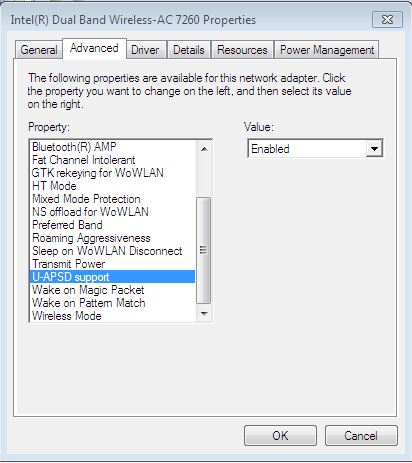TechNote: Access Point Interoperability Issue with uAPSD
This tech note is intended for customers who are experiencing lower-than-expected performance with their wireless adapter.
Issue
Intel has identified IOT (interoperability) issues with certain access points that results in reduced Rx data throughput. When exercising uAPSD, the access point stops doing aggregations on the downlink, resulting in reduced Rx data throughput:
- 11n 20 MHz channel, about 30 Mbps instead of up to 100 Mbps.
-
11n 40 MHz channel, about 60 Mbps instead of up to 200 Mbps.
When the uAPSD feature is disabled, the power savings are not realized. There is no other impact. The power savings revert to the level of a non-uAPSD-capable access point.
Scope
uAPSD is implemented for these Intel wireless adapters, starting with the Intel® PROSet/Wireless Software and Drivers version 16.6:
- Intel® Dual Band Wireless-AC 7265
- Intel® Dual Band Wireless-N 7265
- Intel® Wireless-N 7265
- Intel® Dual Band Wireless-AC 7260
- Intel® Dual Band Wireless-AC 7260 for Desktop
- Intel® Dual Band Wireless-N 7260
- Intel® Wireless-N 7260
Access Points exhibiting the reduced Rx data throughput are:
- TP-Link* TL-WA801N
- NetGear* 3700
Mitigation
Note this is an issue with the access point, not the Intel wireless adapter. As a workaround Intel provides uAPSD enable/disable as a user selection in the Adapter Properties GUI of Intel® PROSet/Wireless Software and Drivers version v17.0.2 (or newer). If disabling uAPSD in the Adapter Properties improves the throughput issue, check with the access point provider for an updated firmware that resolves the issue. The latest version of Intel® PROSet/Wireless Software and Drivers are available on the Intel Customer Support download center site.

Frequently asked questions
Click or the topic for details:
What is uAPSD?
uAPSD is an acronym for Unscheduled Automatic Power Save Delivery, which is a feature of Wi-Fi devices that allows them to save power. uAPSD is also known as WMM-Power Save or WMM-PS. uAPSD is a Wi-Fi capability that provides more power consumption savings on the client, in low periodic latency-sensitive traffic modes, like a VOIP.
uAPSD enables a STA to retrieve unicast Quality of Service (QoS) traffic buffered in the AP by sending trigger frames. During association/reassociation, a STA negotiates uAPSD capabilities with the access point. For a non-uAPSD enabled access point, a STA uses legacy mechanisms as a means to retrieve the legacy power-save buffered frames.
The uAPSD-enabled AP advertises its capability by setting the uAPSD bit of the QoS Info field in either the WMM Information Element or the WMM Parameter Element. This capability is advertised in Beacons, Probe Responses and reassociation Responses.
Other than the two access points listed, are there other access points that exhibit the issue?
Intel and their customers have tested numerous access points, and only the two identified APs exhibit the behavior, but there might be others.Is there any other impact other than reduced Rx data throughput?
Testing and analysis of the issue indicates that reduced Rx throughput is the only symptom.Is the Intel® Dual Band Wireless-AC 3160 adapter affected?
No. uAPSD is not supported by 3160 adapter.| Related topic |
| What are advanced Wi-Fi adapter settings? |